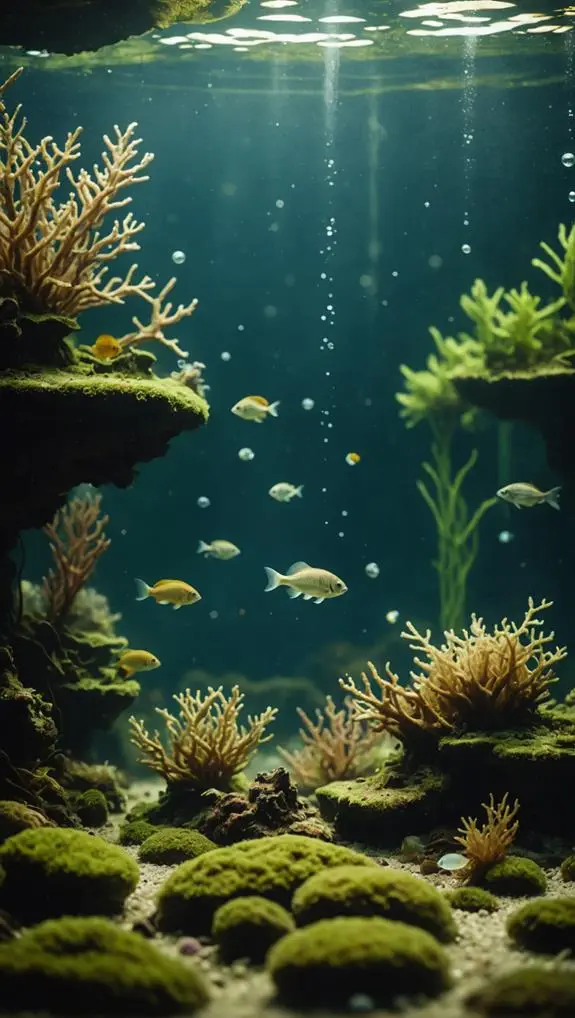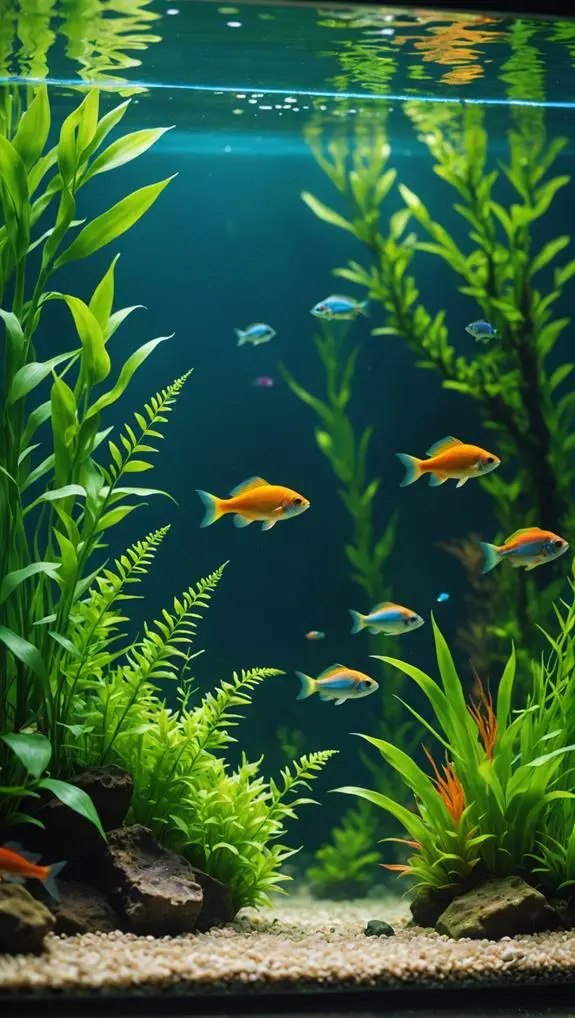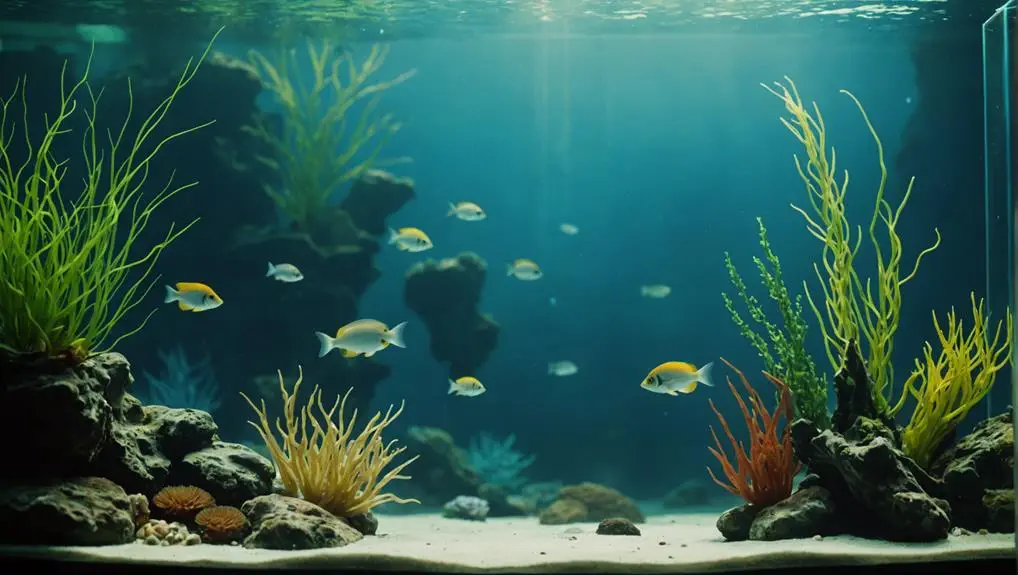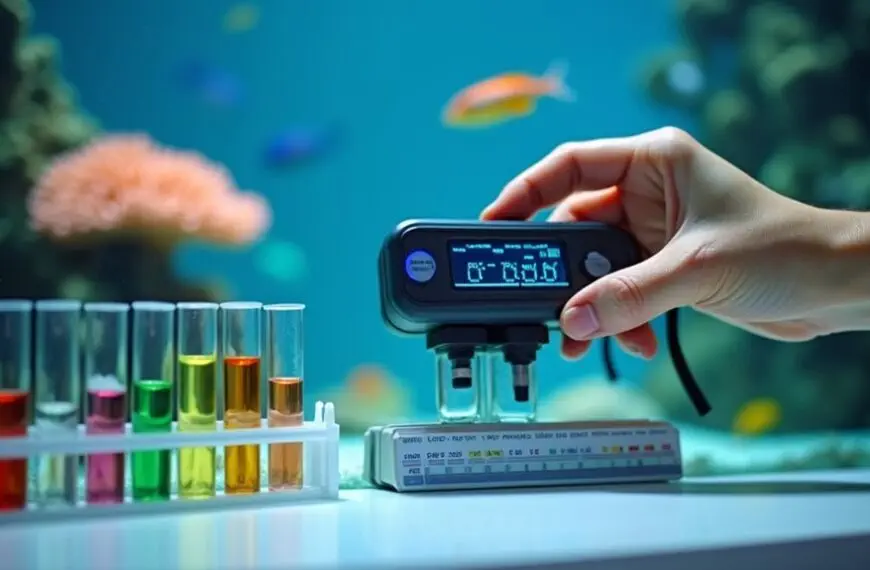When it comes to aquarium water quality, you're bound to encounter a few hiccups. Cloudy water often signals overfeeding or a new tank's struggle to cycle. You might also spot green water thanks to algae growth from excess nutrients. Bad smells? That's a sure sign of decaying food or waste. Plus, ammonia and nitrite spikes can make your fish gasp for air! Don't forget about pH imbalances and low oxygen levels, which can stress your fish. Overfeeding is a common culprit too. Keeping an eye on these issues can keep your tank thriving—stick around to uncover how to tackle them!
Contents
Cloudy Water
Have you ever noticed your aquarium water looking cloudy? It can be a real bummer, especially when you want to create a safe and beautiful home for your fish.
Cloudy water often happens due to overfeeding, where uneaten food breaks down, leading to an increase in fish waste. This not only clouds your water but can also spike ammonia levels, making it tough for your aquatic buddies to thrive.
If you're dealing with new tank syndrome, things can get even trickier. This occurs when your filter isn't cycled properly, causing ammonia levels to rise and resulting in that murky water.
To keep your aquarium crystal clear, regular water changes are essential. Aim for about 25% each month to maintain good water quality.
Stocking your tank wisely is also key. For tropical fish, consider one inch per gallon, and for goldfish, one inch per three gallons. This helps reduce excess waste and keeps everything balanced.
Green Water
Have you ever looked into your aquarium and seen a green haze instead of clear water?
That green water is usually a sign of too much algae, often fueled by overfeeding or too much sunlight.
Don't worry, though; with a few simple changes and treatments, you can get your tank back to its sparkling best!
Causes of Green Water
The proliferation of green water in an aquarium is often a frustrating experience for fishkeepers, stemming primarily from excessive algae growth. You might find that too much sunlight sneaks into your tank, or perhaps you've been overfeeding your fish.
Both can lead to nutrient overload, which is a recipe for an algae bloom.
High phosphate levels are usually the culprit behind this green menace. When food decomposes and waste builds up, it creates the perfect environment for algae to thrive.
To tackle this issue, consider performing a 50% water change. Scrubbing the tank glass and cleaning ornaments with vinegar can also help clear things up.
Treatment Methods Available
To combat green water effectively, several treatment methods can be employed that target the underlying causes of algae growth. First, consider performing a 50% water change. This can significantly reduce ammonia and nutrient levels that fuel algae.
While you're at it, scrub the tank glass and clean ornaments with vinegar to remove stubborn algae clinging on for dear life.
Feeding is another area where you can make a big difference. Limit feeding to once or twice a day, and only offer small amounts. This helps to minimize uneaten food, which is like a buffet for algae.
If you're still struggling with persistent green water, you might try a treatment like Tetra AlgaeControl. It specifically targets and reduces algae populations in freshwater aquariums.
Lastly, don't forget about regular maintenance! Bi-weekly water changes and introducing live aquatic plants can create a balanced ecosystem, making it harder for algae to take over.
Prevention Strategies Effective
Preventing green water in your aquarium requires a multi-faceted approach that focuses on maintaining optimal water quality and limiting algae growth.
First off, feed your fish once or twice daily, but only what they can munch in two minutes. This keeps excess nutrients in check, which are a major contributor to green water.
Regular water changes are another key prevention strategy. Aim for 50% changes every couple of weeks to lower those pesky phosphate levels that fuel algae blooms.
While you're at it, don't forget to scrub the tank surfaces and decorations with a bit of vinegar. It's a simple way to remove algae buildup, improving water clarity and quality.
Incorporating live plants can also be a game changer. They'll absorb nutrients that algae love, giving your fish a healthier environment.
If you find yourself battling algae despite your best efforts, consider using Tetra AlgaeControl. It's a solid option for managing algae populations and keeping your aquarium vibrant.
Bad Smelling Water

If your aquarium water's starting to smell like something's gone awry, don't panic!
Bad odors usually come from leftover food or fish waste breaking down, which can mean trouble for your fish.
Let's talk about what causes these funky smells, how to fix them quickly, and the steps you can take to keep your tank smelling fresh and clean!
Causes of Bad Odors
Bad odors in your aquarium often signal underlying issues like excess waste or decomposing food.
These smells can be unpleasant, but they're also a call to action. High ammonia levels and nitrite levels might be lurking, turning your fish's home into a toxic zone. One big culprit? Overfeeding fish! If you're tossing in too much food, it's likely to rot and add to the organic waste.
To tackle those bad odors, start with a good water change—aim for 50% right away.
After that, another 25% change the next day helps clear things up further. It's like giving your aquarium a refreshing spa day! Regular maintenance is key, too.
Make sure to check your feeding habits and do monthly water changes of about 25%.
Immediate Water Solutions
Addressing bad odors in your aquarium is vital for maintaining a healthy environment for your fish. When you smell something funky, it usually means there's excess waste or decomposing food lurking around, which can lead to ammonia and nitrite spikes. These aren't just fancy words; they're dangerous for your tropical fish!
To tackle this issue right away, perform a 50% water change. This quick fix dilutes those nasty substances. After a day, do another 25% water change to keep improving the water quality. Remember, your fish shouldn't feel like they're swimming in a stinky swamp!
Another key point is to avoid overfeeding. Fish don't need a buffet every day! Feed them just enough to finish in about two minutes.
Also, grab some test kits to keep an eye on ammonia and nitrite levels. Regular testing helps you catch problems before they get serious.
Lastly, make sure you're not cramming too many fish in the tank. Aim for about 1 inch of tropical fish per gallon of water. This will help keep the waste levels manageable and your aquarium smelling fresh. Your fish will thank you!
Preventative Measures Needed
To keep your aquarium smelling fresh, it's crucial to implement preventative measures right from the start. Nobody wants to dive into a stinky tank, right?
First, be mindful of overfeeding. Only give your fish food they can gobble up in two minutes. Leftover food leads to decomposition, and that's a recipe for bad odors.
Next, pay attention to your stocking ratio. Aim for one inch of tropical fish per gallon of water. For goldfish, it's one inch per three gallons. This ensures there's enough space to prevent waste buildup, which can smell pretty nasty.
Regular water changes are your best friend. Aim to change 25% to 50% of the water weekly to dilute any accumulated waste and organic material.
Don't forget about your filtration system! Keep it clean and well-maintained, as a clogged filter can ruin your water quality and create unpleasant smells.
Lastly, check your ammonia levels regularly. If they're high, quick water changes and reducing your fish load can save the day.
Ammonia and Nitrite Spikes
Ammonia and nitrite spikes can create a toxic environment in your aquarium, severely affecting the health of your fish. When ammonia levels rise—often due to overstocking or overfeeding—your fish might struggle to breathe and thrive. You want to keep those ammonia levels at zero for optimal health.
Similarly, nitrite, produced from ammonia breakdown by beneficial bacteria, can suffocate your fish if it's not kept in check.
New tank syndrome is a common culprit here, as new aquariums may lack the necessary bacteria to convert ammonia into safer compounds. This is why frequent water testing is crucial, especially during the cycling process. You can catch those toxic spikes before they wreak havoc on your aquatic friends.
If you notice those pesky spikes, don't panic! Quick actions like performing water changes and improving filtration can help lower ammonia and nitrite levels. Your fish depend on you to maintain water quality, so being proactive can protect them from these harmful conditions.
Ph Imbalances

pH imbalances can pose serious threats to your aquarium's inhabitants, affecting their overall health and well-being. Most tropical fish thrive best in a pH range of 6.5 to 8.
When the pH swings too high or low, it can stress your fish and weaken their immune systems. You wouldn't want that for your finned friends, would you?
Over time, pH levels can drop, making regular testing essential. Water changes are your best friend here! They not only help maintain stable pH but also keep ammonia and nitrite in check.
Also, don't forget about General Hardness (GH); stable hardness keeps pH steady, avoiding drastic changes in water chemistry.
If you need to adjust your pH, consider using reverse osmosis (RO) water. It's a superhero for those of you battling unsuitable local water conditions.
Just remember, sudden shifts in pH can shock your fish. Gradual adjustments are key!
Low Oxygen Levels
Low oxygen levels can severely impact the health of your aquarium's inhabitants. When water circulation is inadequate, and organic waste builds up, your fish might experience hypoxia, which can lead to serious health issues or even mortality. Nobody wants that, right?
To keep things swimming smoothly, enhancing aeration is crucial. You can use air pumps and air stones to boost oxygen levels and improve overall water quality.
Regular maintenance is equally important; make sure to remove uneaten food and vacuum the substrate to combat organic waste. A clean tank not only looks better but also helps maintain healthy oxygen levels.
Remember, most freshwater fish thrive in dissolved oxygen levels ranging from 6 to 8 mg/L. Monitoring these levels regularly is essential for keeping your fish healthy and happy.
Preventive measures, like proper filtration and managing stocking levels, can also go a long way in ensuring your tank is well-oxygenated.
And don't forget, adding live plants can naturally help with aeration too!
Overfeeding Issues

Overfeeding can quickly become a slippery slope for aquarium enthusiasts. You might think your fish are begging for more, but overfeeding can lead to serious water quality issues.
When uneaten fish food accumulates, it decomposes and raises ammonia levels, which can be toxic for your finned friends. To keep your aquarium thriving, follow these simple tips:
- Feed your fish once daily, ensuring they consume everything within two minutes.
- Remove any leftover food promptly to reduce waste buildup.
- Regularly test your water to monitor ammonia and nitrate levels.
Algae Growth
Algae growth can be a frustrating issue for aquarium owners, transforming a beautiful aquatic landscape into a green, murky environment.
This pesky problem often arises from high levels of nutrients in the water, mainly due to overfeeding and waste accumulation. If you're not careful, your tank can turn into a buffet for algae!
To keep algae at bay, try feeding your fish only once or twice a day in small amounts. This simple change can significantly reduce excess nutrients.
Regular water changes are also crucial; aim for a 50% water change while scrubbing those tank surfaces to help manage the issue.
Another fantastic tip is to introduce live plants into your aquarium. They'll compete with algae for nutrients, making it harder for those green invaders to thrive.
If you're still struggling, consider using treatments like Tetra AlgaeControl, which can effectively help reduce those annoying algae blooms in freshwater tanks.
Frequently Asked Questions
What Is Poor Water Quality in an Aquarium?
Poor water quality in your aquarium can stem from ammonia toxicity signs and imbalanced pH levels. Understanding the aquarium nitrogen cycle, maintaining beneficial bacteria, and implementing regular maintenance practices helps ensure healthy water hardness and effective nitrate management.
How Do You Know if Your Aquarium Water Is Bad?
You'll know your aquarium water's bad if you notice chemical imbalances, like nitrate spikes, observe unusual fish behavior, detect odor issues, or see algae growth. Regular water testing helps maintain proper pH levels and fish health.
How to Fix a Poor Water Quality Fish Tank?
To fix poor water quality, start water testing regularly, optimize your filtration system, perform frequent water changes, adjust chemical balance, control algae growth, and consider emergency treatments to ensure your fish's health thrives.
What Are the Problems With Fish Tank Water?
You might think fish tank problems are minor, but ammonia spikes, nitrite toxicity, pH imbalance, nitrate buildup, algae blooms, temperature fluctuations, and hardness levels can harm your fish, so regular monitoring's essential for their health.
Final Thoughts
Keeping your aquarium water healthy can feel like a balancing act. One moment, you're enjoying a clear view of your fish, and the next, you're staring at cloudy water. You can tackle these common issues with a little knowledge and effort. Remember, a happy tank equals happy fish! So, whether you're battling algae or checking pH levels, stay proactive. Your aquatic friends will thank you with their vibrant colors and lively antics. Dive in and make it happen!












